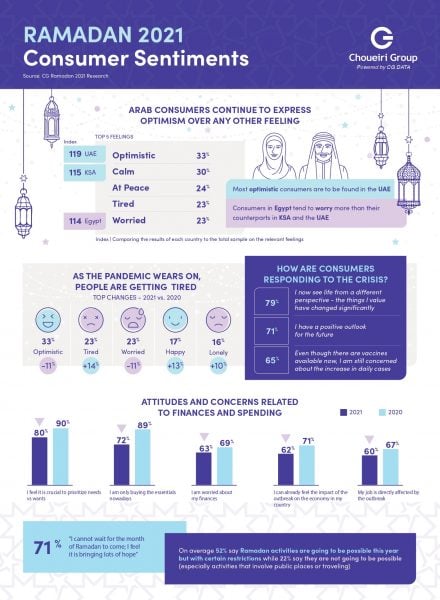 Can you tell us more about why and how the research study behind the infographic (below) was conducted?
Can you tell us more about why and how the research study behind the infographic (below) was conducted?
Ramadan has always been the perfect opportunity for brands to connect with their consumers. But in the face of the ongoing Covid-19 pandemic, many brands are uncertain about what to expect this year.
As part of Choueiri Group’s ongoing efforts to support our clients with consumer insights and empower data-driven decisions, we designed a survey targeting Arab consumers across key markets and managed to achieve a total sample of 1,900 in KSA, 500 in the UAE, and 1,900 in Egypt.
In this research, we explore how consumers feel about the current situation and how they are responding to the crisis. We also investigate their plans relating to different Ramadan activities, and dig deeper into the categories they plan on buying this Ramadan, and how (online vs. offline).
Insights uncovered in this survey will help brands to identify consumer sentiments, pinpoint emerging shopping behaviours and create strategies to seize this calendar opportunity, which is the biggest festive season in the region.
How are people currently responding to the crisis, a year into the pandemic?
Amidst a global crisis that is not in their control, people experience mixed emotions. Adjusting to radical changes over short periods is also never easy.
It is no surprise then that 47 per cent of Arab consumers report difficulties coping with the ‘new life’. But, despite acute challenges, they remain upbeat with 71 per cent expressing positivity about the future. This prevailing sense of optimism mirrors what we recorded earlier during the pandemic in a similar survey that we conducted last Ramadan.
However, in a comparison of Ramadan 2021 and Ramadan 2020 findings, a pronounced change has been recorded across countries. While anxiety is easing, and confidence slowly returning, the pandemic’s dragging-on has led to a drop in optimism. Pandemic fatigue is also kicking in, with monotony leading to exhaustion (tired has increased by 14 per cent). The outbreak has also made it harder to socialise, rendering increases in loneliness (up by 13 per cent from last Ramadan). This divergence from positive/ worried to less positive/ tired and lonely is making people eager to resume life as they knew it.
How are people planning to live out this Ramadan?
Holding a special place in Muslim hearts, Ramadan is an inherently emotional time, marked by gratitude, prayer and family moments. The season delivers hope and is therefore a very welcomed occasion, especially amidst the pandemic. With this being the second Ramadan to have fallen under the pandemic’s watch, there is a lot less uncertainty over how this year’s Holy Month will shape up, especially the restrictions people will have to abide by.
On average, 52 per cent of Arab consumers expect Ramadan rituals and activities to be possible this year with certain measures. This is especially true for social activities including visiting friends and family, as well as public outings (praying in mosques, and visiting shopping centres and restaurants).
What is interesting is that a large majority (59 per cent on average) believe they will be able to plan Eid vacations within the country. Yet people do not expect to travel abroad for Eid, denoting a cautious avoidance of any high-risk activity.
How are shopping behaviours and consumer spending habits being affected?
Ramadan is synonymous with increased spending, but the pandemic has radically altered the environment. Priorities have shifted and consumers are going through different adaptation stages, which affect their purchase decisions. Earlier they were surviving the crisis by limiting their purchases to essentials only. Today they are learning to live with the reality of Covid-19.
Consumers are now beginning to feel that they need to bounce back and buy more than just groceries and household supplies. More people are considering buying Eid gifts, and, compared with the previous Ramadan, the purchase intent is significantly higher across non-essentials. One example is clothing: 31 per cent will increase their spends on Apparel, Shoes and Accessories (up from 8 per cent last Ramadan).
The research also reveals that despite a growing familiarity with the hybrid retail experience (both online and in-store), consumers prefer to visit physical stores for shopping during Ramadan, as this activity is highly associated with this festive season, given the mood that the offline experience offers.
How will this Ramadan differ and what advice would you give to brands?
As the pandemic wears on, consumers are feeling the need to resume activities and live normally again.
Still mindful of their spending and prioritising needs over wants (purchasing essentials), a returning sense of confidence, as well as weariness, is driving up their intention to purchase.
Being at the centre of a global crisis that is disrupting our present and shaping our future, I believe it is essential for brands to swiftly adapt and reflect on consumer insights that can help them understand where audiences stand. I also think there is a higher expectation for brands to accommodate the needs of consumers during this uncertainty, where consumer purchase behaviour and spending habits are continuously changing as a means of adaptation.










